SCERT AP 7th Class Science Study Material Pdf 4th Lesson Respiration and Circulation Textbook Questions and Answers.
AP State Syllabus 7th Class Science 4th Lesson Questions and Answers Respiration and Circulation
7th Class Science 4th Lesson Respiration and Circulation Textbook Questions and Answers
Improve Your Learning
I. Fill in the blanks.
1. Respiration is the process essential for ______ of living things.
2. Inhaled air has ____ oxygen and _____ has carbon dioxide.
3. ______ can breathe both with lungs and skin.
4.The latest respiratory disorder is
1. survival
2. more, less
3. Frog
4. COVID- 19
II. Choose the correct answer.
1. Colour of Haemoglobin is
a) Colourless
b) Blue
c) Red
d) Green
Answer:
c) Red
2. Lime water turns milky when it reacts with
a) Oxygen
b) Nitrogen
c) Carbon
d) Carbon dioxide
Answer:
d) Carbon dioxide
3. The part of respiratory system which branches into
a) Nasal cavity
b) Bronchi
c) Lungs
d) Trachea
Answer:
b) Bronchi
![]()
4. Humans normally breathe times per minute.
a) 14 to 20 times
b) 20 to 30 times
c) 72 times
d) Upto 80 times
Answer:
a) 14 to 20 times
III. Matching
| A) Gills | 1. Earthworm |
| B) Tracheae | 2. Whale |
| C) Lungs | 3. Stem |
| D) Skin | 4. Fish |
| E) Stomata | 5. Cockroach |
| F) Lenticels | 6. Leaf |
| 7. Flower |
Answer:
| A) Gills | 4. Fish |
| B) Tracheae | 5. Cockroach |
| C) Lungs | 2. Whale |
| D) Skin | 1. Earthworm |
| E) Stomata | 6. Leaf |
| F) Lenticels | 3. Stem |
IV. Answer the following questions.
Question 1.
What is respiration?
Answer:
The oxygen reacts with the glucose present in digested food and breaks it down into Carbon dioxide and water to release energy. This process is called Respiration.
Glucose + Oxygen → Carbon dioxide + water + energy
Question 2.
Name the two types of respiration. Write its word equation.
Answer:
Respiration is primarily of two types (a) Aerobic (b) Anaerobic
(a) Aerobic respiration: oxygen involves in this process
Glucose + Oxygen → Carbon dioxide + water + Energy
(b) Anaerobic respiration: oxygen does not involve in this process
Glucose → Carbon dioxide + alcohol + Energy
Question 3.
Write the differences in composition of inhaled and exhaled air.
Answer:
| Composition | Quantity in inhaled air (in %) |
Quantity in exhaled air (in %) |
| Oxygen | 21 | 15 |
| Carbon dioxide | 0.04 4 | 4 |
| Nitrogen | 78 | 78 |
| Water vapour | 0.96 | 3 |
Question 4.
Explain in detail the pathway of respiration in humans with the help of a flowchart.
Answer:
Parts that form the pathway of air in human respiratory system are
1) Nostrils,
2) Nasal cavity,
3) Pharynx,
4) Wind pipe,
5) Bronchi,
6) Lungs.

Question 5.
What are the different respiratory organs seen in animals and their method of working?
Answer:
The organs of respiration are different in different organisms.
A. Tracheae :
- Respiration that take place via tracheae is called Tracheal respiration.
- This is present in all insects. In this system there are openings called spiracles which enter the body of the insect through a network of air tubes called Tracheae.
- The tracheae reach all parts of the body and help in the exchange of gases.
- Ex : Grasshopper, Cockroach, Honey bee etc.

B. Skin :
Cutaneous respiration :
- In some animals the skin is moist and slimy with mucus which helps in breathing through the skin. Ex : Earthworm.
- Frogs have lungs for breathing which they use when they are on land.
- But can breathe through the skin which is moist and slippery while in water.

C. Gills:
Branchial respiration :
- Gills are seen in fishes. Gills are present beneath membranous covers on either side of the head.
- The gills have a rich supply of blood, for exchange of oxygen and carbon dioxide.
- Fish take in water through their mouth which passes out over the gills, the specialized organs to absorb the dissolved oxygen present in the water.
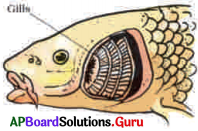
D. Lungs:
- Respiration through lungs is called Pulmonary respiration.
- In all land animals and some water animals the organs for breathing are lungs.
- They are meant for taking oxygen from the air. Ex : Cow, dog, whale, humans etc.
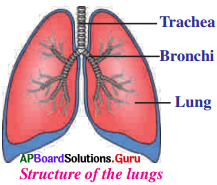
Question 6.
If the diaphragm and ribs do not expand and contract what will be the consequences?
Answer:
- A large thin muscular sheet called diaphragm is attached to the lower side of the ribcage and forms the floor of the chest cavity.
- The process of breathing involves the movement of the diaphragm and the ribcage, in men and women respectively.
- If they can’t contract inhalation and exhalation is not possible
- It means we are not able to breath and it Leads to death
![]()
Question 7.
Write a report on the lab activity done in your school to prove that carbon dioxide is released during exhalation.
Answer:
Aim : To prove that carbon dioxide is released during exhalation What you need: Two small beakers .straw, lime water
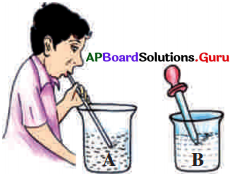
How to do:
- Take two beakers. Label them as A and B.
- Fill two beakers up to half with clear lime water.
- Blow air into beaker ‘A’ using a straw..
- Pass atmospheric air repeatedly into beaker ‘B’ using a dropper.
- Observe the colour change in both the beakers.
What you see:
Lime water is clear and colourless in beaker B , but it turns milky white in beaker A when it reacts with carbon dioxide.
What you learn:
This concludes that there is more carbon dioxide in exhaled air when compared to inhaled air, it is proven that exhaled air contains carbon dioxide
8. Prepare slogans to create awareness about a) evil effects of smoking b) COVID-19 prevention.
Answer:
a) Evil effects of smoking :
Smoking is injurious to health.
Say YES to NO SMOKING
Be smart, Don’t start
Smoking? You must be joking
You don’t have to smoke to be hot!
Be Cool – Don’t Be a Smoking Fool
Don’t take smoke as a joke
Smokers are jokers
Don’t put your lips on fire
b) COVID-19 prevention
Follow the SMS always
SMS means social distance, mask
and sanitization
Don’t neglect be cautious
Wash the hand regularly
Break the chain to kill the corona
Minimum distance is maximum safe
Question 9.
Make use of the Stethoscope made by you to measure the number of heart beats of five of your friends and note down your findings in the table given.
Answer:
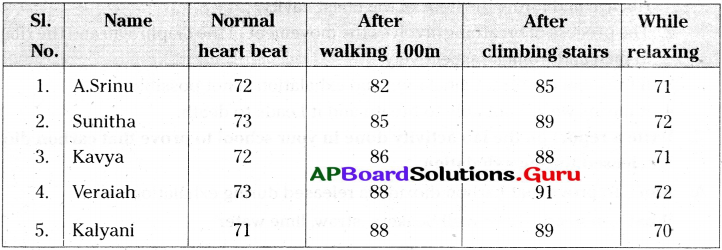
7th Class Science 4th Lesson Respiration and Circulation InText Questions and Answers
7th Class Science Textbook Page No. 53
Question 1.
How fish could breathe in water?
Answer:
Fish has gills, the specialized organs to absorb the dissolved oxygen present in the water. Hence, fish breathe through gills.
Question 2.
Why humans and other animals cannot breathe in water?
Answer:
- Humans, and some other animals have only lungs for breathing.
- But lungs cannot absorb the oxygen from the water.
- ence, they cannot take breathe in water.
![]()
Question 3.
What is breathing?
Answer:
The process of inhalation and exhalation of air is called Breathing.
Question 4.
Inhale deeply. Do you feel air moving inwards?
Answer:
Yes.
Question 5.
Now hold a finger under your nose and slowly release the air. How do you feel now? Do you feel air moving outwards?
Answer:
Yes.
Question 6.
How does the air reach the lungs? What are the organs involved in this process?
Answer:
a) Air reaches the lungs from nostril through various organs.
b) The organs involved in this process are 1) nostril 2) nasal cavity 3) pharynx 4) wind pipe 5) bronchi 6) lungs.
7th Class Science Textbook Page No. 54
Question 7.
How are the lungs expanding and contracting?
Answer:
- When we breathe in, the chest along with ribcage moves upwards and air enters into our lungs. So, lungs expand in inspiration.
- When we breatheout, the chest along with ribcage moves downwards and air goes out. So, lungs contracts in expiration.
7th Class Science Textbook Page No. 56
Question 8.
Why does the amount of oxygen vary between inhaled and exhaled air?
Answer:
Because the oxygen in inhaled air is absorbed in the lungs.
Question 9.
Which gas has increased in quantity in the exhaled air? Why?
Answer:
- The quantity of carbondioxide is more in the exhaled air.
- Because carbondioxide from the blood is transferred to the exhaled air.
Question 10.
In which beaker does the lime, water turned milky white?
Answer:
Beaker ‘A’.
![]()
Question 11.
What does this change indicate?
Answer:
- Carbondioxide turns lime water milky.
- The change indicates that beaker ‘A’ contains more carbondioxide.
- This concludes that there is more carbondioxide in exhaled air when compared to inhaled air.
Question 12.
What happens to the air in the lungs?
Answer:
Oxygen from the inhaled air is absorbed by the blood vessels present in the lungs. Carbon dioxide collected by the blood vessels from all parts of the body enters the Lungs. The absorbed oxygen is transported to every part (Cell) of our body.
7th Class Science Textbook Page No. 57
Question 13.
Checklist.
Tick (✓) the statements which you think are correct and (✗) for wrong me.
1) There is no harm in trying a cigarette once, because one can stop after that. [ ✗ ]
2) Smoking a cigarette once a day is not harmful. [ ✗ ]
3) One can stop smoking only with his will power. [ ✓ ]
4) Smoking helps you feel good and relaxed. [ ✗]
5) Smoking is not harmful to health. [ ✗ ]
Question 14.
What about the smoke inhaled by smokers?
Answer:
- The smoke inhaled by smokers is being sent to all parts of the body.
- Tobacco smoke contains a highly dangerous substance called Nicotine.
- This poisonous substance is also carried to all cells of the body. . ‘
- Smoking leads to lung cancer, tuberculosis and other respiratory disorders.
Question 15.
Do all animals have the same type of respiratory organs?
Answer:
No.
Question 16.
What are the respiratory organs in whales?
Answer:
- Whales breathe air into their lungs,
- They cannot breathe under water like fish can as they do not have gills.
- They breathe through nostrils called a blowhole, located right on top of their heads.
Question 17.
Why is the skin of frog always wet and slimy?
Answer:
- In some animals like frog the skin is moist and slimy with mucus.
- It helps in breathing through the skin while in water.
7th Class Science Textbook Page No. 58
Question 18.
How do plants breathe?
Answer:
- Plants take in oxygen and leave out carbondioxide in breathing.
- They breathe through stomata, lenticels and root hairs.
Question 19.
What are their (plants) respiratory organs?
Answer:
The respiratory organs in plants are
- Stomata in leaves
- Lenticels in stems
- Root hairs in roots.
7th Class Science Textbook PageNo. 59
Question 20.
What changes did you observe in the lime water?
Answer:
The lime water turns milky white.
![]()
Question 21.
Why was there a change in the lime water?
Answer:
The carbondioxide, which was released by the plants (sprouts)’is turned lime water milky white.
Question 22.
How does blood reach al! parts of the body?
Answer:
- Our circulatory system consists of heart, blood vessels and blood.
- There are three types of blood vessels – arteries, veins and blood capillaries.
- These blood vessels are connected to the heart.
- While heart is pumping the blood, the blood capillaries which are connected to the arteries with the veins distribute the blood to the body parts.
Question 23.
How is the oxygen and glucose absorbed by the blood transported to all the parts of our body?
Answer:
- Oxygen and glucose absorbed by the blood transported to all parts of the body through circulatory system.
- The circulatory system consists of heart, blood vessels and blood.
- Blood absorbs the glucose (Digested food) from the digestive system, and oxygen from lungs.
- This blood is pumped by heart to all parts of the body through a kind of blood vessels called arteries.
- These arteries ends in another type of blood vessels called blood capillaries.
- These capillaries are thin arid narrow.
- So, through their thin walls, blood is distributed to all body parts.
- Now oxygen and glucose absorbed by the blood transported to the body parts.
7th Class Science Textbook Page No. 61
Question 24.
Is the blood in all organisms same as In humans?
Answer:
No, the blood in all organisms is not same as in humans.
For example, the colour of human blood is red whereas blue in prawns.
7th Class Science Textbook Page No. 62
Question 25.
Which new disease created a global impact recently?
Answer:
COVID -19 was the new disease that created a global impact recently.
Question 26.
What is a Pandemic?
Answer:
A disease which infects most of the people in a country or the whole world at the same time is called a Pandemic.
Question 27.
How can we prevent it?
Answer:
We can prevent any disease or infection by improving our immunity.
7th Class Science Textbook Page No. 63
Question 28.
Why do we sneeze?
Answer:
- Sneezing occurs when we inhale air with dust, smoke, pollen or strong smells.
- Sneezing expels the unwanted, harmful substances from the lungs.
![]()
Question 29.
Why do we yawn?
Answer:
- Yawning is caused when the respiratory rate gets slowed down resulting in insufficient supply of oxygen to the brain.
- To overcome this situation, the body goes for the involuntary opening of the mouth to take in a long deep breathe of air.
7th Class Science Textbook Page No. 64
Question 30.
What is first aid?
Answer:
The simple assistance provided to a person suffering from injury or serious situations before a doctor attending is called First Aid.
Question 31.
What is the first aid tor drowning?
Answer:
When a person drowns we should first bring him out of the water and make him lay down on the back with the face turned to one side. Check for any sand or mud in the nose, mouth and ears and remove them.
Now, slowly press the abdomen to create pressure on the diaphragm and on the lungs to push out the water that has entered the lungs. Repeat the process by turning the person to lie on the abdomen until recovery. Give some warm clothing and hot tea on recovery.
Think & Respond
Page No. 54
Question 1.
Why is the right lung larger than the left lung?
Answer:
- Heart is located in the centre of the chest cavity slightly bent towards the left.
- So, as a result the left lung being smaller than the right lung.
Activities and Projects
Question 1.
Make use of a water bottle with water and two straws to test your lungs power.
Answer:
- Take a bottle with a lid.
- Make two holes in the lid and insert two straws through them.

- Fill the bottle with water and close its mouth with the lid along with straws.
- Adjust the straws such that one should be till the bottom of the bottle and other till the surface of the water.
- Now blow air with force through the straw placed above the water surface of water.
- As this blowing air put pressure on water, it escapes out through the second straw.
- The hight of the water raises through the second straw or the empty space formed in the bottle indicates your lung power.
Question 2.
Make use of a mirror to know whether our breath contains water vapour as given in the table 2 showing what our breath contains.
Answer:
- Take a mirror in to your hands during morning and blow air on to that.
- You can find that your image in the mirror become blarred.
- Now wipe the mirror with your hand.
- You will find that the image become clear and some moisture touches to your hand.
- This moisture is nothing but the water vapour present in your breath.
- This phenomena can be observed more clearly during winter mornings than summer mornings.
![]()
Question 3.
Prepare a model of lungs using a water bottle, balloons and Y tube to show the importance of diaphragm in respiration.
Answer:
Materials:
Y-shaped tube, a large balloon, two small balloons, a one litre plastic bottle, cork.
![]()
Method of construction :
Cut the plastic bottle to half its size. Fix two small balloons at both ends of the Y-tube. Make a small hole in the cork and fix the Y-tube through the hole as shown in the picture. Cut the large balloon into two halves and fix one half tightly around the open part of the bottle.
Method of working :
Hold the balloon at the middle and pull it slowly downwards. The balloons become inflated (Expands), Now leave the balloon free. Then the balloons collapse (contracts).
The expansion and contraction of the lungs is almost like this. Similar to the balloon tied firmly at the base of the bottle, there is a part called ‘diaphragm’ in our body to control the expansion and contraction of the lungs.
Activities
Activity – 1
Question 1.
How do you perform breathing by an activity?
(OR)
Do an activity to show the stages in breathing?
Answer:
- Inhale deeply.
- You may feel air moving inwards.
- The process of inhaling air is called inspiration.
- Now hold a finger under your nose and slowly release the air.
- You may feel air coming outside.
- The process of exhalation of air is called expiration.
- This activity shows us that there are two stages in breathing – Inhalation and Exhalation.
Activity – 2
Question 2.
How do you prove that there is a difference in the size of the chest cavity during inhalation and exhalation process?
(OR)
Fill in the table with an activity.
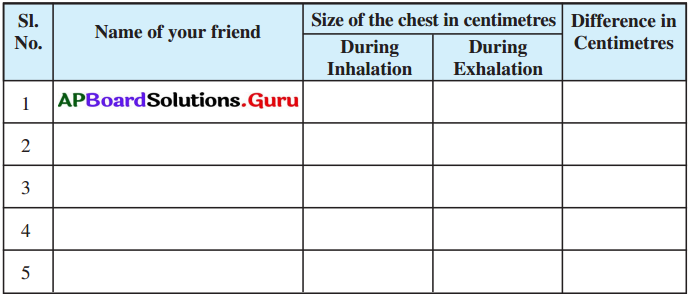
Answer:
1. Take a measuring tape.
2. Hold the tape around the chest of one of your friend and measure the width of her/ his chest.
3. Hold the tape lightly and ask your friend to breathe in and again measure the width of her/his chest.
4. Repeat it with more friends and record your observations in the given table.

5. We can conclude from this activity that there is a difference in the size of the chest cavity during inhalation and exhalation process.
Activity – 3
Question 3.
How do you prove that there is more carbon dioxide in exhaled air when compared to inhaled air?
Answer:

- Take two beakers. Label them as A and B.
- Fill two beakers upto half with clear lime water.
- Blow air into beaker ‘A’ using a straw.
- Pass atmospheric air repeatedly into beaker B’ using a dropper.
- Observe the colour change in both the beakers.
- Lime water is clear and colourless, but it turns milky white when it reacts with carbon dioxide.
- This concludes that there is more carbon dioxide in exhaled air when compared to inhaled air.
Activity – 4
Question 4.
How do you prove that the sprouting seeds respire to take in oxygen and leave out carbon dioxide?
Answer:
Take a wide mouthed bottle and place a handful of sprouting seeds in it. Prepare some fresh lime water in a small container and place it carefully in one corner of the bottle. Close the cap of the bottle and apply vaseline on the edges to make it air-tight. Leave the apparatus undisturbed for a day or two. After two days open the cap and carefully take out the lime water container and observe the changes.

1. What changes did you observe in the lime water?
Answer:
The lime water changes into milky white colour.
2. Why was there a change in the lime water?
Answer:
The sprouting seeds respire to take in oxygen and -leave out carbon dioxide. The lime water in the small container reacts with the carbon dioxide released by sprouting seeds to change into milky white colour.
![]()
Activity – 5
Question 5.
How do you make a stethoscope? What are the material do you require?
(OR)
How do you know the rate of heart beat?
Answer:
Aim : To know the rate of heart beat.
What we need :
Rubber tube, Y – shaped attachment, small funnel, rubber sheet /balloon, steel tongue cleaner, beads or earphone buds, insulation tape.
Procedure:
1. Insert rubber tubes to the three ends of a Y shaped attachment.
2. Arrange a small funnel to the rubber tube attached to the lower single arm of the Y shaped attachment.
3. Tie a rubber sheet / balloon to the broad end of the funnel.

4. Arrange ear buds to the ends of rubber tubes attached to the upper two arms of the Y shaped attachment.
5. Arrange a steel tongue cleaner connecting the two upper tubes over the Y shaped attachment to give support.
Working:
Keep upper two rubber tube ends in your ears. Put the funnel on the chest of your friend and observe the sound of heart beat.